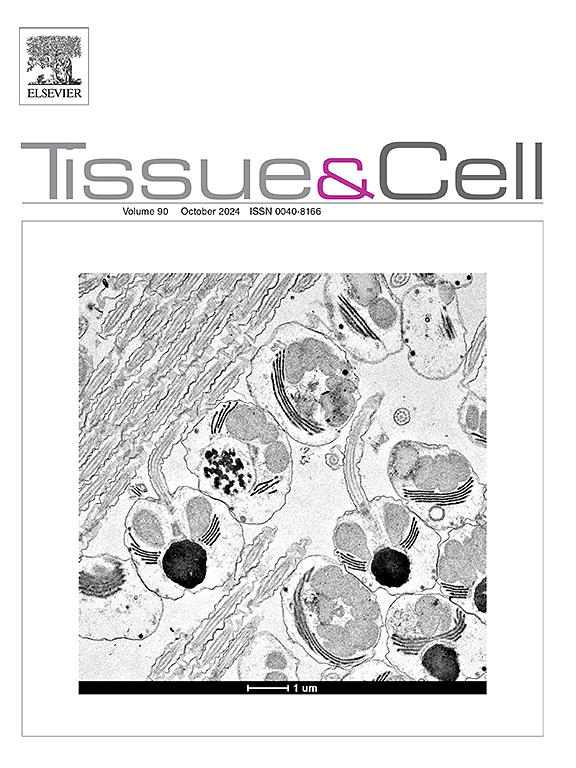SOX2OT抑制可增强NT2细胞神经元分化模型中胆碱o -乙酰转移酶基因的表达
IF 2.7
4区 生物学
Q1 ANATOMY & MORPHOLOGY
引用次数: 0
摘要
目的本实验旨在探讨SOX2OT在NT2细胞神经元分化中的作用,以阐明其在这一过程中的具体功能,尽管先前的研究强调了其在中枢神经系统发育中的重要性,但其功能尚不清楚。材料和方法利用NT2细胞系,通过慢病毒介导的shRNA传递,构建SOX2OT敲低细胞克隆(SNT2)和对照克隆(LNT2)。所有类型的细胞均经过维甲酸诱导的3周神经元分化。与对照组相比,评估包括形态学变化、微管蛋白BIII免疫荧光染色和基因表达的qRT-PCR,包括SOX2OT和神经元标记物(Nestin、CHAT、GFAP)。结果稳定的SOX2OT抑制不影响NT2细胞的神经元分化。SNT2细胞维持了向神经元形态分化的能力,表达Tubulin IIIB蛋白。分化前,SNT2细胞CHAT表达显著升高(p值= 0.01),并持续21 d (p值= 0.037)。虽然分化在对照细胞中引发了SOX2OT表达的轻度早期下降,但在第三周内,所有细胞的SOX2OT表达都有所增加。神经分化导致Nestin基因表达普遍下降,CHAT和GFAP神经元标志物呈升高趋势。到第21天,SNT2细胞中所有基因的表达与NT2对照有显著差异(p值= 0.037),提示SOX2OT在NT2细胞神经元分化中可能起作用。结论SOX2OT构成型敲除NT2细胞仍具有向神经元细胞分化的能力。然而,SOX2OT抑制可影响神经元标志物如胆碱o -乙酰转移酶的表达,提示其在神经元分化过程中的重要性。本文章由计算机程序翻译,如有差异,请以英文原文为准。
SOX2OT inhibition enhances the choline O-Acetyltransferase gene expression in neuronal differentiation model of NT2 cells
Objective
This experimental study aimed to investigate the role of SOX2OT in NT2 cell neuronal differentiation to elucidate its specific function in this process, which remains unclear despite previous research highlighting its importance in central nervous system development.
Material and methods
We utilized the NT2 cell line to create a constitutive SOX2OT knocked-down cell clone (SNT2) and a control clone (LNT2) through lentivirus-mediated shRNA delivery. All cell types underwent 3 weeks of neuronal differentiation induced by retinoic acid. Assessment involved morphological changes, Tubulin BIII immunofluorescence staining, and qRT-PCR for gene expression, including SOX2OT and neuronal markers (Nestin, CHAT, GFAP), compared to the control.
Results
We demonstrated that stable SOX2OT inhibition did not hinder NT2 cell neuronal differentiation. SNT2 cells maintained their ability to morphologically differentiate into neurons, expressing Tubulin IIIB protein. Before differentiation, SNT2 cells showed a significant increase in CHAT expression (p-value = 0.01), persisting after 21 days (p-value = 0.037). While differentiation triggered a mild early decrease in SOX2OT expression in control cells, it increased in all cells during the third week. The neural differentiation lead to a general decrease in the gene expression of Nestin, and elevating trends in CHAT, and GFAP neuronal markers. By day 21, the expression of all genes in SNT2 cells significantly differed from NT2 controls (p-value = 0.037), suggesting SOX2OT's potential role in NT2 cell neuronal differentiation.
Conclusion
The results of this study showed that SOX2OT constitutive knocked down NT2 cells are still capable of differentiating into neuronal cells. However, SOX2OT inhibition can affect the expression of neuronal markers including choline O-Acetyltransferase which suggests its importance in the process of neuronal differentiation.
求助全文
通过发布文献求助,成功后即可免费获取论文全文。
去求助
来源期刊

Tissue & cell
医学-解剖学与形态学
CiteScore
3.90
自引率
0.00%
发文量
234
期刊介绍:
Tissue and Cell is devoted to original research on the organization of cells, subcellular and extracellular components at all levels, including the grouping and interrelations of cells in tissues and organs. The journal encourages submission of ultrastructural studies that provide novel insights into structure, function and physiology of cells and tissues, in health and disease. Bioengineering and stem cells studies focused on the description of morphological and/or histological data are also welcomed.
Studies investigating the effect of compounds and/or substances on structure of cells and tissues are generally outside the scope of this journal. For consideration, studies should contain a clear rationale on the use of (a) given substance(s), have a compelling morphological and structural focus and present novel incremental findings from previous literature.
 求助内容:
求助内容: 应助结果提醒方式:
应助结果提醒方式:


